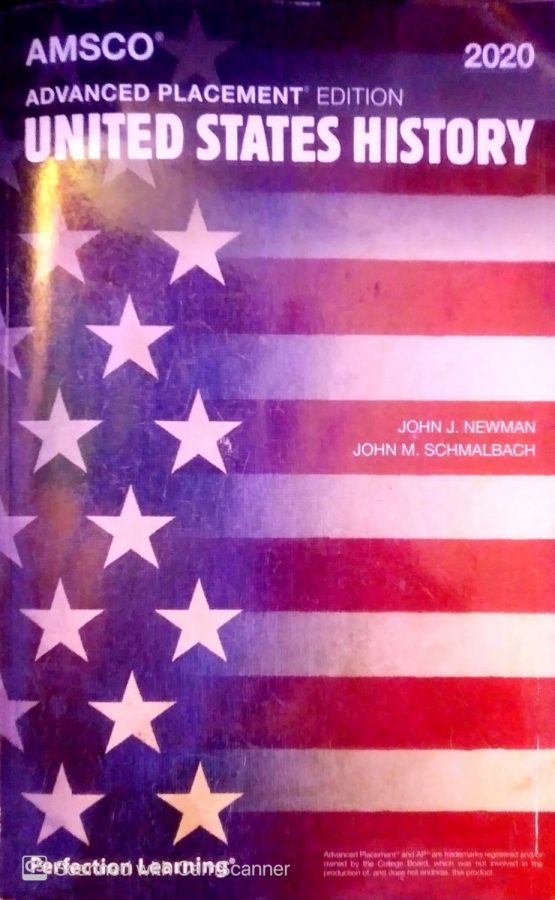The US History curriculum’s holes with Indigenous people
A picture of the AMSCO Advanced Placement Edition United States History textbook that is used in APUSH
December 3, 2020
Throughout our US History textbooks we see representation and people’s perspectives and points of view on different events. However have we truly ever seen a perspective of an Indigenous person?
In Solon High School (SHS), the General US History Curriculum uses HMH Ed program (Houghton Mifflin Harcourt), and the AP US History class uses the textbook, AMSCO: Advanced Placement Edition United States History). HMH Ed is a teaching and learning system that Solon uses in their history classes. The AMSCO: Advanced Placement Edition United States History, is a textbook specifically used for the AP US History class, otherwise known as APUSH.
HMH Ed goes into detail about Indigenous people’s cultures, what happened before the English immigrants came, and the issues they had to deal with throughout their material. However in the AMSCO, Indigenous people are briefly mentioned in eight paragraphs throughout the chapter, “The New World 1491-1607.” The eight paragraphs can be summarized as talking about their cultures and languages, but lacks finer details. It also talks about settlements in specified areas such as Northeast and Southwest.
Looking at the Ohio Standardized Curriculum for Social Studies, Indigenous people are only discussed in the eighth grade section under the “Colonization to Independence” topic.
Mrs. Kosiorek, an Assistant Principal at SHS, explains that the curriculum itself is generally a main idea, and the teachers are supposed to fill in the details. However, the Ohio curriculum standards are lacking when it comes to the history of Indigenous people. This perpetuates the idea that Indigenous people only need to be talked about when talking about the colonization and expansion of the US. They’re continually silenced with their culture and what the early Americans did to them, as well as the idea of colonization.
I asked Dan Iwan, a US History teacher currently working at SHS, if he thought colonization was the right term when dealing with the expedition of Christopher Columbus and so forth. He believes that colonization can fit in at least a few periods of US History. Iwan says, “Before the Civil War, the US treated Native Americans as a conquered people, essentially taking their land and forcing them west.”
Although we did colonize America, the horrendous atrocities done to Indigenous people are rarely being talked about. Being forced into Christianity, enslaving them, pushing them off their sacred land, bringing in diseases that the Indigenous people were not immune to, raping Indigenous women, etc..
I recently found out these things on social media apps such as Tiktok and Twitter. Users of the app have started to educate others with events that aren’t being taught throughout school. These apps still bring awareness to social issues and more, some even give factual evidence, however, it is always best to fact check yourself as well.
Anthony Newton, a student that attended Solon Middle School and is now attending Bridgewater Raritan High School in New Jersey said, “I have learned stuff that I did not learn from school at all that I should have definitely learned, from Tiktok, which is kind of a problem.”
The Solon school system has come a long way with trying to incorporate more stories from people of color. However, there is still improvement that needs to be made. Kosiorek goes into detail on how Solon is looking for ways to improve.
According to Mrs. Kosiorek, she and others had met up with the Young Democrats and African-American Culture Club. They had met with their advisers and were given feedback on how the students had felt about the curriculum and its Eurocentric point of view. Mrs. Kosiorek and others had taken that feedback and developed a group consisted of teachers, they are trying to increase resources with more diverse perspectives to provide teachers with.
“So we are giving different perspectives and not only in history, it’s in English classes. What our authors are reading, what type of novels are we reading? Are they giving the perspective of all of our diverse students, not just black and white, but our other minorities and other perspectives that we can get? So we’re trying to do it. This group, this committee we have formed is meeting to give examples or a way to find resources for English, for history. How can the science classes incorporate different perspectives? Science and math? You don’t think of can’t. But maybe there are the scientists and the mathematicians that are discussing when they do have word problems or situations. Are we doing it from a diverse perspective and not just the white perspective?” Mrs. Kosiorek says.
Mrs. Kosiorek goes on to say that teachers aren’t capable of changing everything in one year, instead the progress will be slow and gradual on how we introduce new topics into the curriculum.
Although what you learn in school shapes your views, opinions, and outlooks. It would be best if you took the time to look at these types of things outside of school, and educate yourself. The article, “Different resources to educate yourself with on Indigenous Peoples’ Day” written by Melany Dillon an author working at The Daily Californian, gives out multiple books and resources on the culture, folktales, experiences, and contributions of Indigenous people.

